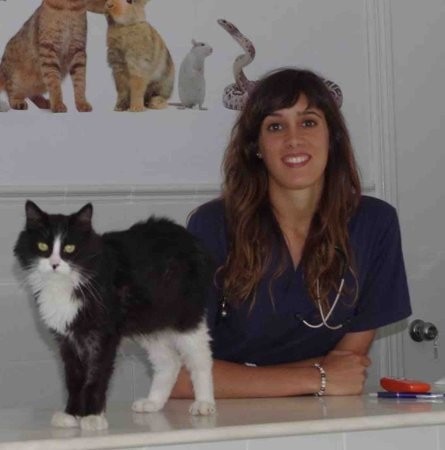Examples of these conditions include diabetes mellitus, that may require injections of insulin, or chronic kidney disease, which can predispose pets to dehydration (especially in cats) and may benefit from receiving subcutaneous fluid therapy.
The subcutaneous route relies in the administration of medication or fluids in the space underneath the skin, which will allow the slow absorption of the product into the bloodstream. However, in certain situations, for example if your pet is severely dehydrated due to vomiting or diarrhoea, this route may not be appropriate, and your pet may require to be hospitalised for intravenous fluid administration.
Your veterinary surgeon or nurse will be able to explain how to administer an injection or fluid therapy to your pet, but the instructions below may be used as general guidelines.
Your vet will provide you with the necessary equipment to administer the injections or fluid therapy, and will instruct you on the specific amount of medication or fluids to administer.
If the medication or fluid bag shows a cloudy or abnormal appearance, do not use it and contact your veterinary surgeon.
Generally, the equipment required for administration of subcutaneous medication consists of:
- Needles of adequate size
- Syringes
- Fluid bag for fluid therapy
- Fluid line to connect the fluid bag with the needle
- Sharps bin for safe disposal of the needles
It is helpful to have someone to assist you until you acquire more experience, but with time, you may be able to do it without assistance. During the process, you can stroke or give your pet some treats, to make it a positive experience, unless recommended otherwise by your vet. In case of diabetic patients, insulin is usually administered after eating.
How to administer subcutaneous medication
Have all your equipment ready and the medication drawn up. Follow the instructions regarding mixing or shaking the content of the bottle. To draw up the medication, attach the needle to the syringe, turn the bottle upside down and introduce the needle to obtain the volume required. Extract the needle and remove any air bubbles and confirm if the volume is correct.
Find a comfortable position for you and your pet. They can be lying on their bed or on your lap. Lift the loose skin, usually from the back of the neck, with one hand between your thumb and index finger and introduce the needle parallel to the body into the lifted skin with the bevel pointing upwards.
Use your dominant hand to administer the medication and the other hand to lift the skin. Once the needle is under the skin, push the plunger completely with the thumb of palm of your hand to introduce the content and finally withdraw the needle. Do a gentle massage.
If your pet moves and you are unsure of the amount of drug administered, contact your vet, and generally do not inject more unless instructed.


How to administer subcutaneous fluid therapy
Have your equipment ready. To do this, remove the fluid bag and line from the packaging. Then close the line with the roller. All the areas that have a protective cap, should not be touched with the hands to avoid contamination. The fluid line will have an upper sharp end that will be introduced into the fluid bag and a lower end that will be connected to the needle that will be introduced in your pet’s skin. Introduce the sharp end into the fluid bag by piercing the ‘rubber’ area of the fluid bag; usually there is a protective cover that needs to be removed. Hang the bag at a height next to the area where you will be administering the fluids to your pet and then squeeze the chamber at the top of the fluid line until it is half full.
Subsequently, you should open the roller that was previously closed and allow the fluid to flow until you see fluid dripping from the lower end and then close the roller again. Make sure there are no large bubbles within the line. After this, you should connect the lower end to the needle. Again, do not touch the tip of the fluid line or needle to avoid contamination or injury.
- Once you have your equipment ready, find a comfortable area and position for your pet where you will be for the following 15-30 minutes.
- Sometimes cats may be happier in a box or bed. You can attempt different positions until you find the one that your cat prefers.
- Like the described method for administration of subcutaneous medication, lift the loose skin from the back of the neck or the lower back and introduce the needle, perpendicular to the lifted skin. Then you can release the skin and hold the needle. With your other hand, open the roller and the fluid will start running.
- To finish the procedure, close the roller and remove the needle from the skin. Remove the needle from the fluid line and dispose it appropriately. You can place a fresh needle with its cap in the fluid line to prevent contamination while is being stored. Store the fluids in a cool and dry place.
- There will be a ‘lump’ forming under the skin where the fluid is being introduced. This will reabsorb. If the fluids stop running, you can reposition the needle by moving it gently, as this is usually due to obstruction. This may occur several times during fluid administration.










